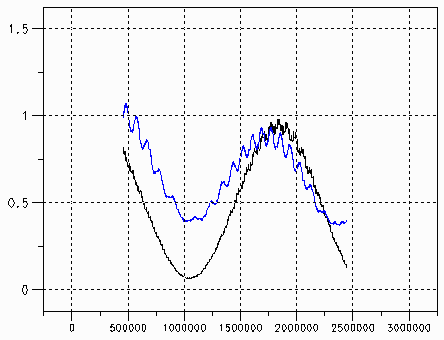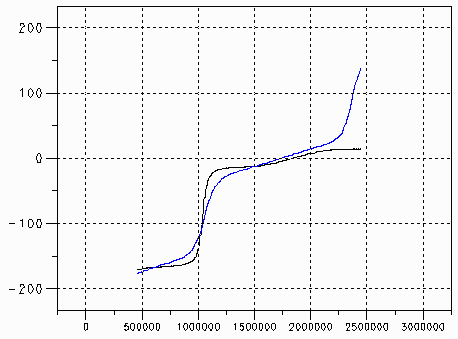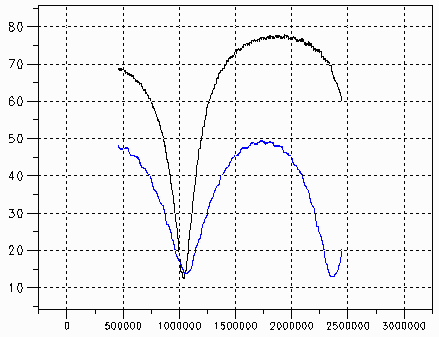
Perihelion distances (AU) for 96P (black) and 2000 PG3 (blue)
2000 PG3 and 96P/Machholz
I have searched through MPCORB.DAT (from 2009 Sep 18) to find orbits similar to 96 P/Machholz or the Kracht/Marsden group comets. The search was confined to asteroids with a longitude (L) and latitude (B) of perihelion within about +/- 5 degrees of 96P/Kracht/Marsden comets (L>97 and L<107 and B>6 and B<16 degrees) and q < 1 and number of oppositions>1.
These criteria are matched by four asteroids (and compared here with 96P including the semimajor axis (a)):
| Designation | L | B | q | a |
| 2000 PG3 | 106.9 | 13.6 | 0.406 | 2.827 |
| (138727) 2000 SU180 | 104.7 | 8.2 | 0.827 | 2.104 |
| 2001 TC45 | 101.3 | 14.2 | 0.794 | 2.218 |
| 2003 SK84 | 102.8 | 7.9 | 0.650 | 2.533 |
| 96P/Machholz | 102.0 | 12.6 | 0.124 | 3.032 |
2001 TC45 is closest to (L,B) of 96P, but has an orbital period of only 3.3 years. 96P has an orbital period of 5.5 years and the Kracht/Marsden comets are thought to have orbital periods of about 5 to 6 years. 2000 PG3 with an orbital period of 4.75 years is much closer to them (the perihelion distance of 2000 PG3 also fits better). One can ask if 2000 PG3 is truly related to 96P and the Kracht/Marsden comets.
The current (epoch JD 2455000.5, 2009 June 18) orbital elements don't look very similar (especially in q, peri, node, incl):
| Designation | a | e | q | peri | node | incl | L | B |
| 96P/Machholz | 3.0320 | 0.95908 | 0.1241 | 14.78 | 94.29 | 58.24 | 102.0 | 12.6 |
| 2000 PG3 | 2.8274 | 0.85635 | 0.4062 | 141.09 | 323.74 | 21.97 | 106.9 | 13.6 |
I have integrated with SOLEX the motions of 96P and 2000 PG3 back until JD 455000.5 (that is for 2000000 days or 5476 years). The results show that q, peri, node, incl of 96P and 2000 PG3 were much more similar in the past and have evolved similarly:.

Perihelion distances (AU) for 96P (black) and 2000 PG3 (blue)

Arguments of perihelion (degree) for 96P (black) and 2000 PG3
(blue)

Longitudes of node (degree) for 96P (black) and 2000 PG3 (blue)

Inclinations (degree) for 96P (black) and 2000 PG3 (blue)
The integration of 96P was done without nongravitational forces as we don't know how they have evolved over several thousand years. Another uncertainty is the orbit of 2000 PG3, which we know only from 152 observations from 3 oppositions. Given these uncertainties we don't know if 2000 PG3 is a member of the Machholz Complex or not. But the similarities of 96P and 2000 PG3 shown here strongly suggest that they are related.
While 2000 PG3 seems to be dormant or extinct today, it may have shown cometary activity and nongravitational forces in the past. Pulat B. Babadzhanov and Iwan P. Williams wrote: "The character of the orbit and low albedo of 2000 PG3, and the existence of the meteor showers associated with 2000 PG3 provide evidence supporting the conjecture that this asteroid may be of cometary nature." (in: Is the near-Earth asteroid 2000 PG3 an extinct comet?).
2000 PG3 has about the same diameter as 96P (6 - 7 km), it could make an important contribution to the Machholz Complex.
Rainer Kracht 2009 September 28